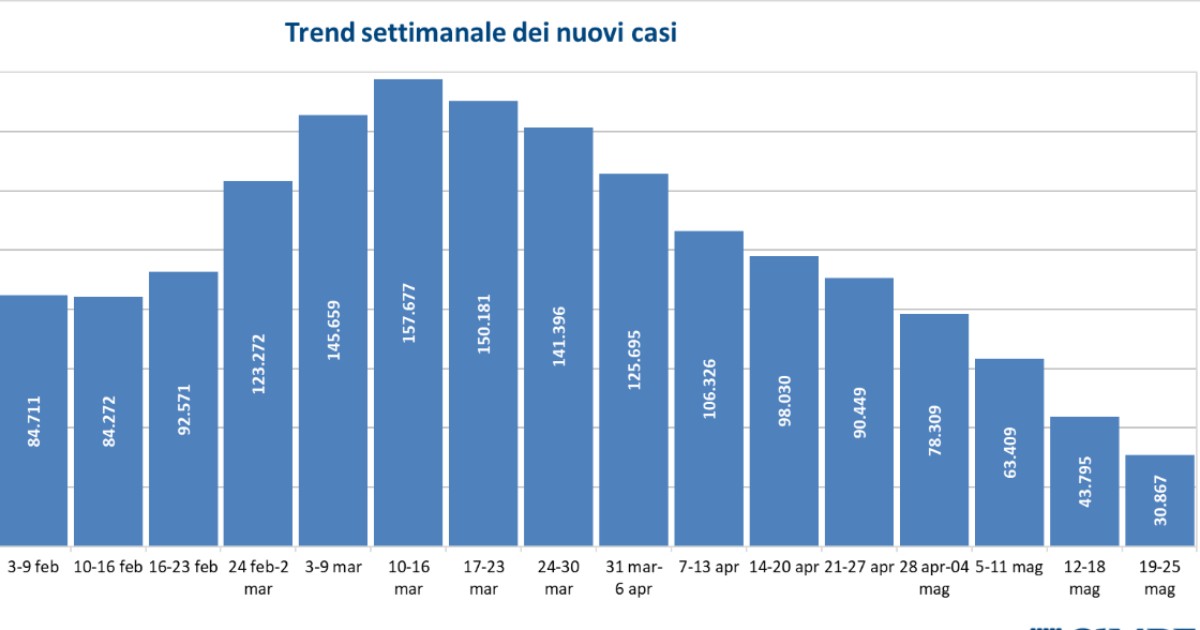Net decline in hospitalizations and beds employed in intensive care, thanks also to the effect of vaccines, and decreasing incidence in all regions. But the vaccination campaign risks delays given the delays in deliveries: according to the plan, 42.6 million doses remain to be delivered 5 weeks before the end of the second quarter, and it is “unrealistic” to think that the numbers “expected by the end on June”. This is what emerges from the latest independent monitoring by the Gimbe Foundation which emphasizes three critical points above all: “First of all, the new criteria for assigning colors to the Regions discourage the resumption of contact tracing just when the reduction of cases would make it feasible, explains the president Nino Cartabellotta – secondly, the failure to implement active call vaccination strategies to increase the coverage of the most vulnerable groups; finally, the strategy for promptly identifying any possible resumption of the contagion is not known “.
Specifically, the monitoring notes that in the week just passed, from 19 to 25 May, compared to the previous one, there was a further decrease in new cases, down from 43,794 in the seven days from 12 to 18 May, to 30,867 in the last week, with a decrease of 29.5%. Deaths are also decreasing: they were 1004 compared to 1215 the previous week. The number of hospitalized patients with symptoms has swooped, reaching 8557 compared to 11.539 the previous week, and intensive care is also empty, with a decrease of 21.7%: the number of beds occupied is 1.323, with a decrease of -366. “For the tenth consecutive week – specifies the president of the Foundation – new weekly cases continue to drop, partly due to the reduced circulation of the virus, as documented by the reduction of the positive / tested cases ratio, partly due to the growing decrease in testing activity ”. According to the report data, in fact, the number of people tested fell by 12.2% (-69.010) compared to last week. Numbers that increase to 24.9% if you look at the testing of two weeks ago. The trend of the decline in infections, in any case, is recorded throughout Italy, with 8 regions, Abruzzo, Friuli-Venezia Giulia, Liguria, Molise, the Autonomous Province of Trento, Sardinia, Umbria and Veneto, with a weekly incidence lower than 50 cases per week per 100 thousand inhabitants, i.e. the threshold below which tracing can be recovered.
The high vaccination coverage of the over 70s also affects the declining numbers of hospitalizations. The same cannot be said, however, “for cases in home isolation”: being on average younger, in fact, they are not still largely immunized and therefore the curve decreases more slowly. In detail, if from the peak of 6 April the number of beds occupied in the medical area fell from 29,337 to 8,557 (-70.8%), and those in intensive care from 3,743 to 1,323 (-64.7%), people in home isolation from the peak of March 28 went from 540,855 to 258,265 (-52.2%)
Despite the positive influence of the vaccination campaign, there are still many people to be immunized: “Overall – he underlines Renata Gili, Head of Research on Health Services of the Foundation – over 3.7 million over 60s at high risk of hospitalization and death have not yet received even a dose vaccine and more precisely: 7.6% of the over 80s (n. 336,061); 18.4% of the 70-79 bracket (1,099,757); 31.3% of that 60-69 years (no. 2,306,916) “. Faced with a drop in doses for the 60-69 age group, the surge in the 50-59 age group stands out. “More generally – comments Cartabellotta – some Regions, rather than using other strategies to increase vaccination coverage of over 60s, are expanding their population targets in a very diversified way with the primary objective of keeping the number of administrations high “. Regional differences are also evident: Puglia, Veneto, Lombardy, Molise, the Autonomous Province of Trento, Lazio and Emilia-Romagna exceed 80% of over 60s who received the first dose, while regions such as Calabria and Sicily still remain. below 70%. Overall, in Italy, 78.9% of the over 60s still received the first dose of vaccine, with 82.2% of the over 80s who, on the other hand, completed the vaccination cycle.
Above all, they worry deliveries of vaccines. As of May 26, 33,618,267 doses were delivered, equal to 44.1% of those planned for the 1st half of 2021. In detail, Pfizer-BioNtech had to arrive over 41 million doses, but only 22 million arrived. Moderna, on the other hand, delivered 56.4% of the planned doses, that is 3,371,357. Further back, AstraZeneca gave Italy 7,382,080 million doses, that is 52.1%. Johnson & Johnson deliveries were almost absent: 7,307,392 doses had to be delivered, but only 723,750 arrived.
The numbers speak for themselves: “Considering that there are 5 weeks left until the end of the 2nd quarter, to comply with the supplies provided for by the vaccination plan by the end of June 42.6 million doses are still missing“, Explains Cartabellotta again. For this reason, according to the Gimbe Foundation, “it is unrealistic” that by the end of June we will “have” all the foreseen doses. There are three reasons for this: “the irregular deliveries from AstraZeneca, the very few doses delivered by Johnson & Johnson which announced further delays, the non-submission to EMA of the CureVac conditional trade authorization application that it was to deliver to Italy, in the first half of the year, over 7.3 million doses.
–


